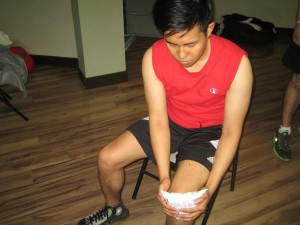A torn calf muscle usually happened during acceleration or changes in direction. A calf strain injury happens in the middle of the leg or knee within the muscle belly.
There are 2 muscles that form the lower leg or calf – the deeper soleus muscles and the gastrocnemius muscles which are more superficial or closer to the skin. This muscle attaches the heel to the back of the knee and function to plantar flex the ankle and for extension of the knee which are needed for running, walking, kicking and jumping.
Classification
- Grade 1 – the muscles are stretched and cause tiny tears in the fibers of the muscle. It usually takes about 2 -4 weeks to fully recover.
- Grade 2 – partial tearing of the fibers of the muscles and takes about 4-8 weeks to fully recover along with good rehabilitation.
- Grade 3 – a severe calf strain with complete tearing or rupture of the muscle fibers in the lower leg. It takes about 3-4 months to fully recover and sometimes there is a need for surgery.
Symptoms of a torn calf muscle

- Mild twinges or sharp local pain can be felt at the back of the lower, usually in the middle or closer to the knee.
- Loss of strength and motion
Treatment
- Take plenty of rest especially the affected calf. Avoid performing activities that can make the condition worse.
- Apply an ice pack on the affected area. Wrap ice cubes or frozen gel using a towel and apply on the affected area immediately to help prevent internal bleeding and lessen the inflammation. The cold compress should be applied at least 10-15 minutes every hour. The area should be elevated on a chair or use a stack of pillows when applying the cold compress. You can compress the ice pack against the injury using a compression bandage or an elastic support to prevent bleeding from the affected area at least 15 minutes at a time. Avoid tying the compression bandage too tight to prevent constriction of blood flow and cause further damage to the leg.
- Take the prescribed over-the-counter anti-inflammatory medications such as ibuprofen, naproxen or aspirin to lessen the inflammation and pain caused by the torn calf muscle.
- Perform light stretching to help relieve tension in the muscle and increase flow of blood. Stretching also helps the scar tissue change and becomes more flexible. Wrap around a towel or compression bandage underneath the foot near the toes. Hold each end of the towel or compression bandage and slowly pull and slowly extend both legs and feel the deep stretch in the calf muscles. Remain in this position for 20-30 seconds and then slowly release. Perform the stretches at least 3-5 times every day for a week for as long that it does not cause pain. Seek the help of a physical therapist before performing this exercise to prevent making the condition worse.
Tips
- Before performing any athletic activities, warm up and then stretch the calf muscles to help prevent injuries such as sprains, strains and muscle cramps.
- Wear a heel pad in the shoe for a few days to help raise the heel and shorten the damaged calf muscle and lessen the tension and pain.
